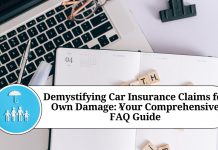Introduction
Owning a bike comes with a sense of freedom and convenience. Whether you use it for commuting or as a source of recreation, your two-wheeler is a valuable asset. However, accidents and mishaps are an unfortunate reality, and they can lead to significant financial losses. That’s where Own Damage Insurance for bikes comes into play. In this blog, we will explore the concept of Own Damage Insurance, its importance, coverage options, and how it can safeguard your bike investment.
What is Own Damage Insurance?
Own Damage Insurance, also known as Comprehensive Insurance, is a type of insurance policy that provides coverage for damages caused to your bike due to various incidents. It goes beyond the basic third-party liability coverage and offers protection against risks such as accidents, theft, fire, natural calamities, and vandalism.
Importance of Own Damage Insurance:
a. Comprehensive Coverage: Own Damage Insurance provides extensive coverage for both third-party liability and damages to your own vehicle. It offers financial protection against a wide range of risks, ensuring that you are not left with a hefty repair or replacement bill.
b. Peace of Mind: Knowing that your bike is protected against unforeseen events brings peace of mind. Whether it’s a minor scratch or a major accident, you can rest assured that the insurance will come to your rescue and minimize the financial burden.
c. Asset Protection: Your bike is a valuable asset that you have invested in. Own Damage Insurance helps safeguard this investment by covering repair costs or compensating for the loss in case of theft or irreparable damages.
d. Legal Requirement: In many countries, including India, having at least third-party liability insurance is mandatory for all vehicle owners. Opting for Own Damage Insurance not only fulfills this legal requirement but also offers additional protection for your own vehicle.
Coverage Options under Own Damage Insurance:
a. Accidents: Own Damage Insurance covers damages caused to your bike due to accidents, whether it’s a collision with another vehicle or a single-vehicle accident. It includes both minor damages and major repairs or replacements.
b. Theft and Vandalism: If your bike gets stolen or vandalized, Own Damage Insurance provides compensation for the loss. This coverage is particularly important in areas with higher crime rates or when parking your bike in public spaces.
c. Natural Calamities: Natural disasters like floods, earthquakes, cyclones, and storms can cause significant damage to your bike. Own Damage Insurance offers protection against such events and covers the repair or replacement costs.
d. Fire and Explosions: In the unfortunate event of a fire or explosion damaging your bike, the insurance policy will provide coverage for repairs or compensate for the loss, depending on the extent of the damage.
e. Additional Covers: Some insurance providers offer add-on covers that you can opt for at an extra cost. These include coverage for accessories, engine protection, roadside assistance, and zero depreciation. Assess your requirements and choose the additional covers that suit your needs.
Factors Affecting Own Damage Insurance Premiums:
a. Bike’s Insured Declared Value (IDV): IDV is the maximum sum assured by the insurer in case of total loss or theft. The premium for Own Damage Insurance is directly proportional to the IDV. Higher IDV will result in a higher premium and vice versa.
b. Bike’s Age and Condition: Older bikes generally have lower premiums compared to newer ones. The condition of the bike, such as its maintenance, modifications, and previous claims history, can also impact the premium.
c. Location: The premium may vary based on the location where the bike is registered and primarily used. Areas prone to theft or natural calamities may have higher premiums.
d. No Claim Bonus (NCB): If you haven’t made any claims during the previous policy period, you are eligible for a No Claim Bonus. This bonus reduces the premium for the following year, motivating you to maintain a claim-free record.
Conclusion
Investing in a bike is not just about buying the vehicle; it’s about protecting your investment against unforeseen circumstances. Own Damage Insurance offers comprehensive coverage for your bike, providing financial protection and peace of mind. By understanding the coverage options, assessing your requirements, and considering the factors affecting premiums, you can choose an insurance policy that suits your needs. Remember, safeguarding your bike with Own Damage Insurance is a wise decision that ensures you enjoy the ride without worrying about unexpected expenses.
Read more useful content:
Frequently Asked Questions (FAQs)
Q1: What is Own Damage Insurance for bikes?
A1: Own Damage Insurance, also known as Comprehensive Insurance, is a type of insurance policy that provides coverage for damages caused to your bike due to various incidents. It includes coverage for accidents, theft, fire, natural calamities, and vandalism, in addition to the basic third-party liability coverage.
Q2: Is Own Damage Insurance mandatory for bike owners?
A2: Own Damage Insurance is not mandatory in most countries. However, having at least third-party liability insurance is usually a legal requirement. Opting for Own Damage Insurance is a personal choice, but it provides additional protection for your own vehicle.
Q3: What does Own Damage Insurance cover?
A3: Own Damage Insurance covers damages to your bike caused by accidents, theft, fire, natural calamities, and vandalism. It includes repair costs and compensates for the loss in case of irreparable damages or total loss. Some policies may also offer additional covers like coverage for accessories, engine protection, roadside assistance, and zero depreciation.
Q4: Does Own Damage Insurance cover accidents caused by my negligence?
A4: Yes, Own Damage Insurance covers accidents caused by your negligence or fault. It provides coverage for damages to your own vehicle regardless of who is at fault in the accident.
Q5: Will Own Damage Insurance cover the entire repair cost of my bike?
A5: The coverage provided by Own Damage Insurance depends on the terms and conditions of your policy and the extent of the damages. The insurance company will typically cover the repair costs up to the Insured Declared Value (IDV) of your bike, which is the maximum sum assured in case of total loss or theft.
Q6: Can I customize my Own Damage Insurance policy?
A6: Some insurance providers offer add-on covers that allow you to customize your policy according to your needs. These add-ons may include coverage for accessories, engine protection, roadside assistance, and zero depreciation. You can choose the additional covers that suit your requirements and budget.
Q7: How are premiums for Own Damage Insurance calculated?
A7: Premiums for Own Damage Insurance are calculated based on several factors such as the Insured Declared Value (IDV) of the bike, its age and condition, the location where it is registered and primarily used, and your previous claims history. A higher IDV, newer bike, higher-risk location, and previous claims can result in higher premiums.
Q8: What is No Claim Bonus (NCB)?
A8: No Claim Bonus (NCB) is a discount offered on the premium if you haven’t made any claims during the previous policy period. It is a reward for maintaining a claim-free record. The NCB can significantly reduce the premium for the following year.
Q9: How can I make a claim for Own Damage Insurance?
A9: In case of an accident or damage to your bike, you should inform your insurance provider immediately. They will guide you through the claim process, which typically involves submitting the necessary documents such as a claim form, photographs of the damages, and repair estimates. Follow the instructions provided by your insurance company to ensure a smooth claims experience.
Q10: Can I transfer my Own Damage Insurance to a new bike?
A10: Yes, Own Damage Insurance can be transferred to a new bike. You will need to inform your insurance provider about the change in the insured vehicle and provide the necessary details. The premium for the new bike may vary based on its Insured Declared Value (IDV), age, and other factors.

































